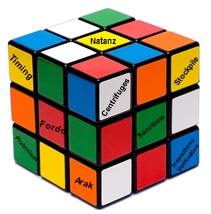 There’s no one single formula for a nuclear deal with Iran. The United States compares negotiations to solving a Rubik’s Cube™, because so many pieces are involved—and moving one moves all the others. (The world’s most popular puzzle has 43 quintillion permutations to solve it so all the colors match on the six faces.) These are some of the key issues in the Rubik’s Cube of a nuclear deal.
There’s no one single formula for a nuclear deal with Iran. The United States compares negotiations to solving a Rubik’s Cube™, because so many pieces are involved—and moving one moves all the others. (The world’s most popular puzzle has 43 quintillion permutations to solve it so all the colors match on the six faces.) These are some of the key issues in the Rubik’s Cube of a nuclear deal.
CENTRIFUGES: Since 2002, Iran has built centrifuges to enrich uranium, which can fuel both peaceful energy and deadly bombs. Tehran claims it is only for medical research and energy. But Iran’s abilities far exceed its current needs; Russia provides fuel for Iran’s single nuclear reactor.
Iran now has about 19,000 centrifuges—up from less than 200 a decade ago. The vast majority of these are first-generation “IR-1” centrifuges, but Iran has begun installing much more sophisticated “IR-2” models. About 10,000 are enriching uranium at Iran’s two enrichment facilities, Natanz and Fordow; the rest are installed but not operating. The more
A deal will try to reduce the number of Iran’s centrifuges. Outside experts suggest the goal could be to limit Iran to between 2,000 and 6,000 operating IR-1 centrifuges, and place constraints on research and development into more advanced machines.
A final deal could seek to limit enrichment to five percent or less.
A deal could seek to limit the stockpile of 5 percent enriched uranium and require Iran to further reduce its stockpile of 20 percent uranium in oxide form. Iran may be allowed to keep some for research, but not enough to quickly build a bomb.
A deal will try to limit the program at Natanz.
A deal will try to end enrichment activities at Fordow, perhaps converting it to a research-only facility.
A deal will try to close Arak or redesign it in a way to substantially reduce plutonium output. A deal will also try prohibit Iran from building a reprocessing facility.
It may also cover access to sites suspected of past work on bomb components, such as Parchin military base. And it is likely to require Tehran’s acceptance of the IAEA’s “Additional Protocol,” allowing inspections at both declared and undeclared sites—and maybe other intrusive measures.
- Preserving key elements of its nuclear program, including some uranium enrichment and research and development
- Protecting Iran's "right" under the Non-Proliferation Treaty to a peaceful nuclear energy program to alleviate the drain on its oil sources and fuel modern development
- Removing nuclear-related sanctions on Iran by the United States, European Union and United Nations
#Iran’s red lines in the #NuclearTalks pic.twitter.com/YEQOLeJphX
— Khamenei.ir (@khamenei_ir) October 12, 2014
July 14 Update: Iran released the most detailed report to date explaining its practical needs for its nuclear program. It was posted on the quasi-official website NuclearEnergy.ir.
For more information, see:
Photo credits: Rubik's Cube by by Lars Karlsson (Keqs) (Own work) [GFDL (http://www.gnu.org/copyleft/fdl.html), CC-BY-SA-3.0 (http://creativecommons.org/licenses/by-sa/3.0/) or CC-BY-SA-2.5-2.0-1.0 (http://creativecommons.org/licenses/by-sa/2.5-2.0-1.0)], via Wikimedia Commons [edited by Iran Primer], President.ir
